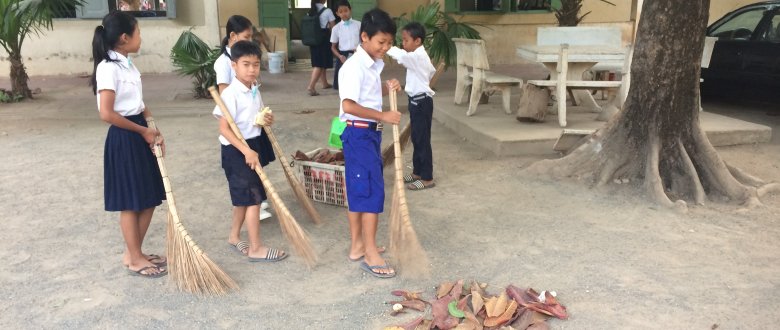
The SMART programme has an ambitious goal; it wants to stimulate and support school leaders to establish eco-friendly school environments.
Eco-context in schools
In Cambodia, every week a person uses on average 52 plastic bags. That is about 2700 plastic bags per person per year[1]. There is an over-consumption of single-use plastics such as cups, bottles, bags, straws and boxes in Cambodian cities. The same plastic pollution continues in schools where children bring in take-away foods and drinks from market stalls or vendors, who sometimes even sell their foods and drinks inside the school compound.
A poor waste management system and policy has led to illegal dumping, burning of waste and an accumulation of waste in waterways, drainage systems, streets and public areas.
What happens in daily life is sadly also perpetuated in many schools. Waste management is only one element that can be improved in schools. There are many other elements that will contribute to a school becoming GREEN.
Challenging school leaders
The SMART programme will challenge school leaders to act together with their teachers, pupils and community members to make their school environmentally conscious and active. School leaders can really make a difference within their school by actively involving the teaching staff and students in this green process. It can lead to a change that will reach beyond the school gates into the homes and community of the teachers and pupils.
The VVOB team visited the target group school leaders in Battambang and Phnom Penh to identify what actions they had envisioned to turn their schools into green schools, and needed some support with. Several clear priorities could be identified:
- The school leaders want to set up or improve their school waste management policy and system. More precisely, the school leaders want to take action on how school waste is collected, how it is processed and how some of it could be reduced, re-used or recycled. More than 65% of the school leaders also indicated that they aspire to make their school free of plastic bags and styrofoam boxes.
- Healthy food and food hygiene were other concerns that the school leaders wish to tackle. Both the school canteen and the vendors that sell to pupils outside the school compound can do a better job offering a wider variety of healthy food options, handling their food and drinks more hygienically and using less single-use containers or cutlery that are not biodegradable.
- Offering a green learning environment with trees and plants is another priority of the school leaders. It not only contributes to a healthy and enjoyable learning environment but also forms a part of the teaching curriculum.
In a next step the VVOB team will develop a manual that will guide the school leaders to turn their school into a green school.
Eco-school Guideline
In the training that will be organised in 2018 the target group school leaders will learn, discuss and share experiences on the most effective ways to make their schools greener and they will get more familiar with the ministry’s eco-school guideline.
In 2016 the Ministry of Environment (MoE) and the Ministry of Education, Youth and Sports (MoEYS) jointly developed a National Guideline on Eco-schools in Cambodia. The guideline offers schools a set of criteria to become an eco-school that recognizes the value and implements environmental sustainability practices. The criteria encompass (a) school policies and administration on environment, (b) teaching modules and learning activities about environment in school and surrounding communities, (c) environmental facilities and practices and (d) partnership and community outreach.
The eco-school guideline is a handy instrument that will be used by the VVOB team to coach the school leaders while they implement their green action plans.






